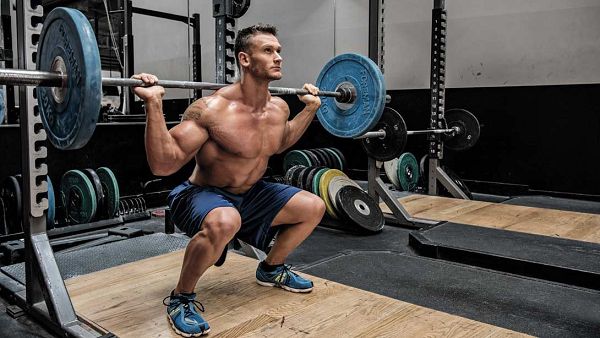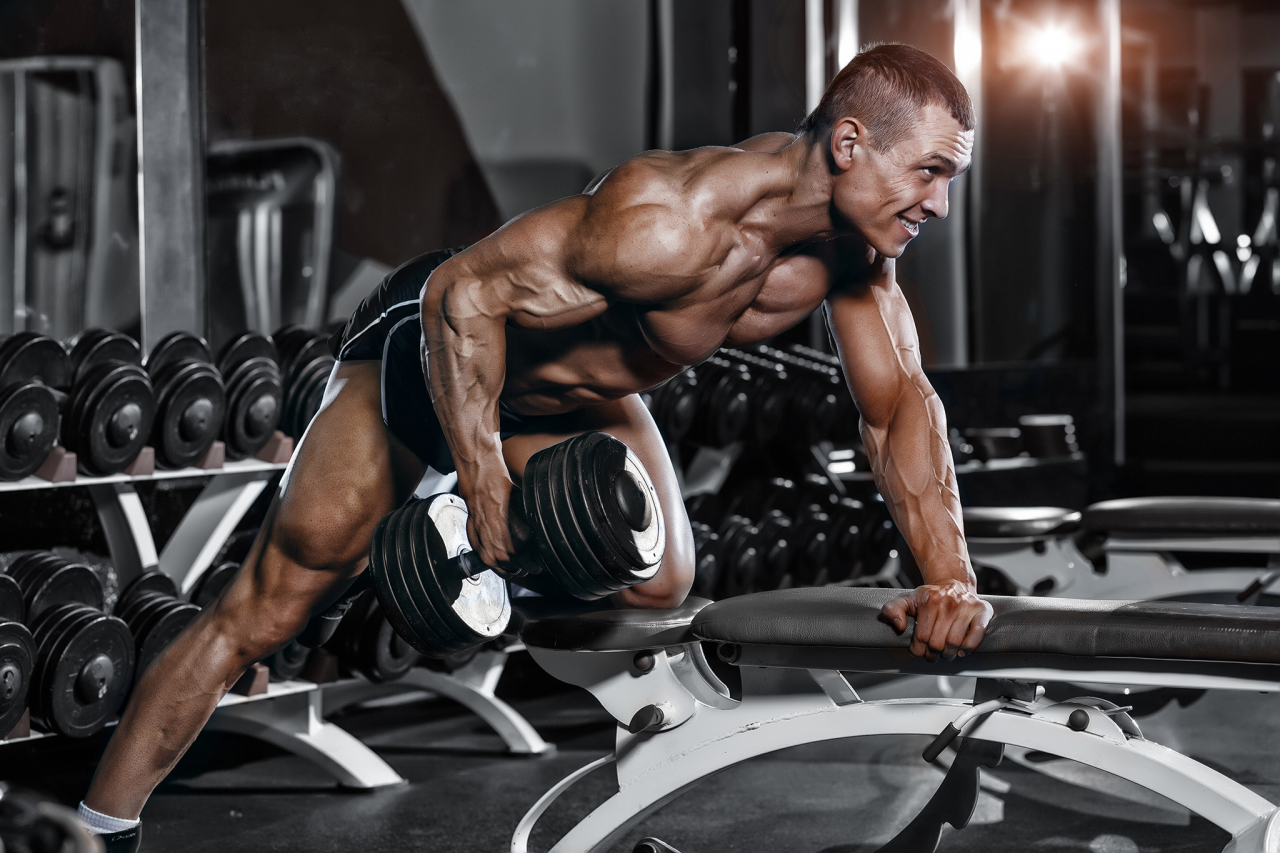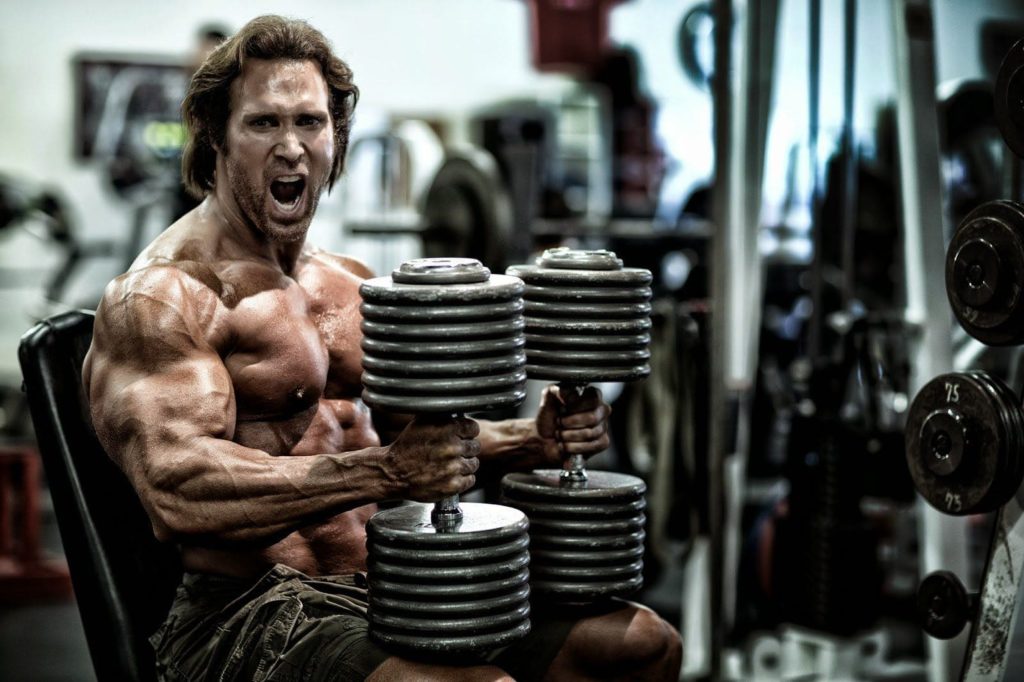
Squats are a basic element of any weightlifting workout. The exercise comprehensively develops the figure and increases the athlete’s strength indicators.
Target muscles
The main load is taken on yourself quads and buttocks. The extensors of the back, hamstrings, soleus, and calf muscles act as stabilizers. Abs and deltas are indirectly loaded.
The benefits of exercise
Strength squats have many advantages for the athlete:
- Increase in total mass body and muscle strength.
- Improving mobility and coordination by strengthening the ligaments, joints and stabilizing muscles.
- Maintaining the health of the male reproductive system by stimulating testosterone production and increasing blood circulation in organs of the small pelvis.
- Getting rid of subcutaneous fat, thanks to the inclusion of large muscle groups.
- Formation of toned hips and rounded buttocks in women.
Beginners can also benefit from light shoulder squats. Moderate loads in combination with a basic multi-joint exercise help to form a muscle corset, strengthen ligaments and tendons.
Squat Technique
Before starting the exercise, you should prepare mentally. Try to focus as much as possible on the exercise. Concentrating on the weight you lift helps you complete the set:
- Approach the barbell, located at the level of the collarbones, grab the bar with a straight closed grip. The width of the palms is selected individually. As a rule, the arms are positioned slightly wider than the shoulders. This is necessary so that the shoulder blades remain flat and the back is straight throughout the entire approach. If the shoulder joints are tight, you can spread your arms wide, but this grip increases the likelihood of loss of balance.
- Firmly squeeze the bar with your palms, slightly sit on your feet and step forward. After passing under the bar, substitute your second foot and rise. In this case, the shoulder blades should come together, and the bar should rest on the upper back. If done correctly, the weight will rest on the trapezius muscle and supported by the back deltas. If you feel strong pressure on the vertebrae, step back and repeat the approach to the bar.
- Tighten your leg muscles, straighten your knees and remove weight from the supports. Take a step back, then substitute the other leg. You don’t have to go far from the racks. Look up at an angle. This will help keep your lower back arched and reduce the risk of losing your balance. Spread your feet wider than your shoulders and turn your toes slightly to the sides. Fix this position and concentrate as much as possible before squatting.
- With a deep breath, begin to take your pelvis back and spread your knees to the sides. Do not “fall” forward. A natural tilt as a result of pelvic abduction will be sufficient. Your squat should be like lowering your buttocks into an imaginary chair. Having descended to the lowest point, immediately begin to rise, powerfully exhaling air from your lungs. In this case, lift by straightening the legs, and not straightening the back.
We figured out the basic technique, now we will consider some important nuances:
- Boom position. If you lower the bar below the rear deltoids, then the load will shift to the buttocks. This method of retention is used by girls with light squats. This positioning of the bar is not recommended in strength training, as it increases the forward bend and the risk of losing balance.
- Depth of the squat. Affects the engagement of the buttocks and lower back. The deeper the athlete descends, the more these areas are loaded. We also note that a lower squat increases the range of motion, which has a positive effect on the growth of strength indicators. If your goal is to gain muscle mass, lower yourself just below the horizontal position of the hips. If you are a weightlifter, squat all the way.
- Knee position. One of the basic rules of a safe squat is that the knee joints should not go beyond the toes. If this happens, then you are not pulling back the pelvic region enough. With this performance, the traumatic load on the ligaments of the knees increases. We recommend that you postpone the strength squats and work with the technique.
- Feet position. It is selected individually. The wider the feet are spread, the greater the load the gluteal muscles receive. In strength squats, we recommend placing your legs at shoulder level or slightly wider. Keep your socks turned in the same direction as your knees.
Before squatting, be sure to warm up your entire body with cardio and do several approach sets with minimal weights.

How to pick up the weight
Remember: for muscle growth, you need to do 6 to 12 reps per every working approach. With a smaller amount, strength indicators will increase, with a larger amount, endurance will increase. In this case, the refusal should occur on the last two repetitions.
Let’s analyze an example algorithm for weight selection for beginners:
- Let’s say you decide to work for the bulk. For beginners, we recommend that you limit yourself to 10 repetitions per set.
- Throw a couple of 10 kg pancakes on the bar and secure them with locks to get an average weight for an unprepared athlete (40-50 kg).
- Try perform 10 squats observing the technique.
- If you did 8–9, and there was a refusal, the weight was selected correctly. If all 10 reps were easy for you, add 5 kg on each side and repeat the approach.
- Add weight until you reach failure on 8 squats.
Using this method, you can learn how to select the starting weight in all strength exercises. The number of sets in basic squats for beginners should not exceed 5-6. At the same time, the first 2 are warm-up, with an empty bar, the rest are workers.
Effect of exercise on the lower back and knees
With strict adherence to the technique, squats do not harm the musculoskeletal system. On the contrary, they strengthen muscles and ligaments, which makes the athlete more mobile and faster. Beginners often make the following critical mistakes:
- extending the knee beyond the line of the fingers;
- “rounding” of the spine;
- no sagging in the lower back;
- bringing the knees inward;
- shifting body weight to toes and lifting heels;
- lifting the bar with your back, not your legs.
Try to exclude these errors, as they can cause not only pain, but also serious injury.
If pain does appear during squats, stop exercising and try assess your condition.
Dull pain in one place, as a rule, indicates a slight sprain. In such a situation, we recommend using analgesic ointments and refraining from physical activity for several days.
If the pain is sharp, interfering with normal movement, seek help from a doctor. Self-treatment can only exacerbate the injury.
Squats in the Smith Machine
The machine is a power rack with rails to which a sliding bar is attached … Let’s briefly list the benefits of squats in this machine:
- accentuated impact on the muscles of the thighs and buttocks;
- safe development of squatting techniques;
- no risk of loss of balance and falls;
- the ability to squat for people with sore knees.
As the bar moves in one plane, stabilizing muscles are excluded from the work. On the one hand, this reduces the overall effectiveness of the exercise, on the other, it allows beginners to strengthen the muscles and ligaments of the legs, without fear of injury.
Squats for girls
Girls are often afraid to strongly “swing” their hips and therefore avoid power squats. In fact, this is not to be feared. To pump up large, voluminous thighs, you need impressive weights and increased production of growth hormones. Women naturally have low hormonal levels, so muscular legs like men do not threaten them.
Women’s fitness programs, like as a rule, they are aimed at losing weight and “drawing” the relief. Consequently, all exercises in them are designed to be performed with low weights and for a large number of repetitions (15–20). Therefore, squats will not increase the girl’s muscle mass, but will only give the buttocks a rounded, toned look.
Here is an example of a fitness program for working out the gluteal muscles and hips:
- Warm-up: trainer or running lane – 5-7 minutes at an easy pace.
- Squats in the Smith frame – 3×15.
- Lunges with dumbbells in the hands – 3×15.
- Incline Leg Press simulator – 3×15.
- Reverse lunges – 3×15.
- Romanian deadlift – 3×15.
- Calf Raises – 3×20.
Rest between approaches – 1 minute. At the end of the workout, you can perform 1-2 elements per press, for example, twisting on the floor (3×20) and the bar (3×40 seconds).

Varieties
You can perform the exercise not only in classical technique. Let’s analyze other, no less effective variations of squats.
Sumo squats
Feature – wide stance of the feet. Thanks to this, the buttocks are more actively involved in the work, which allows you to lift more weight than with the standard technique. Sumo Light Barbell Squats are great for girls looking to work out the inner thighs and glutes.
Front Squats
Performed with the barbell held on top of the chest and deltas. In such squats, the body moves vertically, without bending, which allows you to almost completely eliminate the buttocks and shift the load to the quadriceps. Not recommended for beginners because of the complex technique.
With narrow legs
The technique is the same as in classic squats, only the feet are already shoulders. Used by professional bodybuilders to accentuate the outer and lateral thighs. Not suitable for beginners due to the risk of losing balance.
Lunge squats
The athlete puts a barbell on his shoulders, puts one leg forward, the other takes back … Then, on inhalation, he lowers the pelvis to the parallel of the thigh with the floor, with an exhalation, he returns to an upright position. Exercise qualitatively loads the muscles of the thigh and buttocks. Suitable for girls and beginners.
Gakkenshmidt Squat
The athlete lowers the barbell to the floor and turns his back to it. Then he lowers the pelvis, grabs the bar and stands up. The arms and back are straight, the chest is slightly turned forward, the gaze is directed at an angle upward. Slow squats are performed from this position.
At the bottom, the pancakes touch the floor, but without the “beating”. The technique allows you to work out the quadriceps and calf muscles well. Beginners can do hack squats in a power rack from stands.
Zercher Squats
The bar is placed on the racks of the power rack, approximately at lumbar level. Throwing a soft towel over the bar is recommended. The athlete presses the elbow bends against the barbell, squeezes the palms into the lock, removes the weight from the stops and takes a step back. The legs are slightly wider than the shoulders, the back is straight. Squats are performed from this position.
Exercise allows you to work out the quadriceps qualitatively. In this case, the load from the lower back is almost completely relieved.
Equipment
Power squats, even with the correct technique, create pressure on the lower back and knee joints. Therefore, in order to protect these areas from injury, we recommend the use of sports accessories. Use a weightlifting belt for the lower back, and special elastic bands for the knees.
If you want to squat with a lot of weight, get barbells with heels. Such shoes will help to perform the exercise correctly, without lifting the heels and shifting the weight to the toes.

Contraindications
Squats with weights should not be performed for the following diseases and conditions:
- sciatica;
- scoliosis;
- spinal and abdominal hernias;
- varicose veins;
- knee or spine injury;
- recovery period after surgery;
- pregnancy;
- exacerbation of chronic diseases;
- disorder of the vestibular apparatus.
If in doubt about the safety of squats just for you, be sure to visit a doctor. Otherwise, you may harm yourself and aggravate any disease.